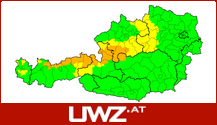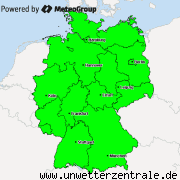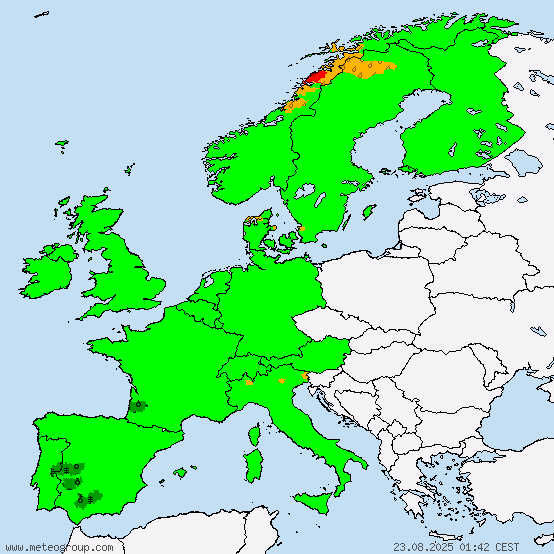(c) - ESTOFEX
Storm Forecast
Valid: Tue 07 Jul 2015 06:00 to Wed 08 Jul 2015 06:00 UTC
Issued: Mon 06 Jul 2015 22:27
Forecaster: TASZAREK / PUCIK
A level 2 was issued for parts of Germany, Switzerland and France, W Czech Republic, W Poland mainly for the damaging wind gusts, large and very large hail, excessive precipitation and in the lesser extent for the tornadoes.
A level 1 was issued for Denmark, Benelux, parts of France, Austria and Italy, E Poland and E Czech Republic mainly for the large hail and excessive precipitation.
A level 1 was issued for parts of Ukraine and Russia mainly for the large hail and severe wind gusts.
SYNOPSIS
A cold front belonging to the trough over Ireland will enter W Europe. During the forecast period the trough will move towards Scandinavia and bring polar air mass to Central Europe. Another trough placed over Finland and Russia will weaken during the day but provide conditions for thunderstorms over these area. Ridge with tropical warm and moist air mass extends from Spain up to Austria. Most of the SW, S and SE Europe is covered with strongly capped tropical air mass where the CI is not likely. Jet streak with winds up to 50 m/s on the 300 hPa level extends from the Ireland, N France and Germany up to the Baltic Sea. This jet will overlap over parts of Central Europe with high boundary layer's moisture and thermodynamic instability thus providing favorable conditions for the severe weather outbreak. A shortwave is predicted by NWP models to pass during the forecast period through France, Benelux, Germany and Poland.
DISCUSSION
... E France, N Switzerland, SW to NE Germany, W Czech Republic, W Poland ...
In the warm advection regime, models simulate moisture return at the lower levels over the region in southwesterly flow. At the same time, a plume of steep lapse rates will be advected atop this layer, creating latent instability. As both lapse rates and low-level moisture increase southwards, so will CAPE values. These will range from a few hundreds J/kg over the northern part of Lvl 2 to perhaps up to 2000 J/kg of MLCAPE over the southern parts of Lvl 2, especially near the Alps, where lapse rates of over 8K/km are simulated. In conjunction with the approaching trough, mid-tropospheric flow will increase, resulting in 15 to 30 m/s of DLS over Level 2, with the highest values in the northern and western parts. Such overlap of CAPE and strong DLS will favor well-organized convection, including supercells and QLCS.
NWP is generally inconsistent regarding CAPE values and also regarding the degree and exact timing of initiation. It is possible that some isolated storms will already form in the early morning or noon hours. The highest threat of severe weather should come from the DMC being initiated along or ahead of the cold front in the late afternoon or evening hours. The first storms forming at the western fringe of Lvl 2 will likely organize into supercells, which will be capable of large hail and severe wind gusts. Very large hail will also be possible with supercells developing in areas with moderate to high CAPE especially over the southern half of Lvl 2. Towards the night, as storms quickly progress eastwards, it is possible that their clustering will yield a linear system with bowing segments. These would pose a threat of severe to extremely severe wind gusts. However, we are uncertain about the exact convective mode evolution and track of such system(s). Should the isolated convection persist, tornadoes will be possible in the evening with increasing LLS and decreasing LCLs.
...SE France, Austria, Italy, E Czech Republic...
In the weakly sheared environment, no good storm organization is predicted. However, locally the high CAPE values (up to 4000 J/kg) may itself create a risk for the occurrence of the large hail and severe wind gusts within the pulse thunderstorms. Since storm motion is weak and the PW values are very large (>40mm), excessive precipitation and local flash flooding cannot be ruled out, especially in the N Italy.
...NE France, Benelux, N Germany, Denmark, Poland...
Although models predicts very large DLS over these areas (25-30 m/s) they are not as consistent with CAPE values and CI. The most optimistic GFS predicts that in the NW Germany CAPE up to 2000 J/kg may overlap with 30 m/s DLS and > 10 m/s LLS. In such conditions if convection will occur, thunderstorms may quickly become supercells and create threat for the large and very large hail and tornadoes as well. If this scenario will come true, the highest threat will fall on the late evening hours. However, there is a high uncertainty whether the predicted thermodynamic instability by the GFS is correct, and due to this, we issue only a Lvl 1 for these area. The same problem concerns Poland where the CAPE prediction in the late evening and night hours is uncertain as well. However, thunderstorms will occur in this area most likely during the night and the convection will become elevated, therefore the degree for the severe weather will decrease. Severe wind gusts will remain to be the main threat.
...parts of Ukraine and Russia...
Thunderstorms are predicted to occur over the cold front approaching from the NW. The overlap of CAPE up to 2500 J/kg and DLS up to 15 m/s (in the area of the forecast domain) will likely organize convection into multicells. The main threat within these storms will be large hail and severe wind gusts. DMC is forecast to start around noon and the storms should weaken in the late evening hours.
X
Replies: 0 • Hits: 931
2015.07.07. - ESTOFEX Forecast / ESTOFEX Vorhersage
Linus Höller - President of M.I.L.K. weather 
- Linus

-
Posts: 2.140 Points: 1.549 Date registered 04.09.2012
Replies: 0 • Hits: 931
Current warnings




© M.I.L.K. 2017
M.I.L.K. - Meteorology: Information. Learning. Knowledge.


